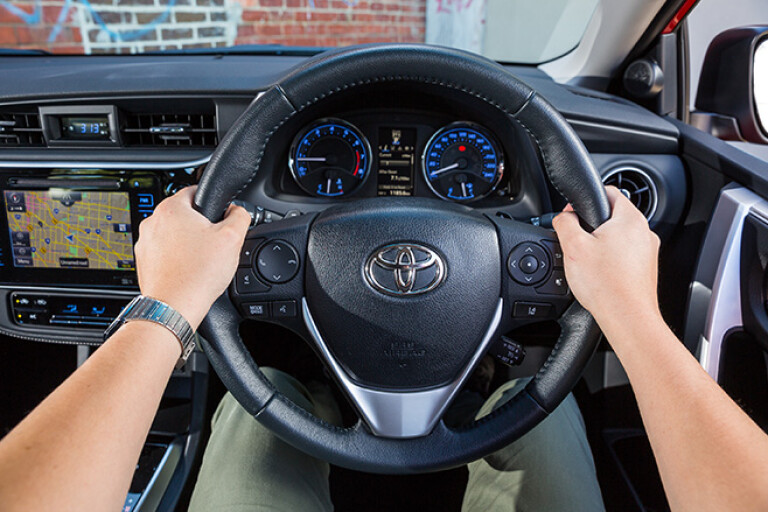
Holding the wheel
If you prefer to grip the wheel with your right hand at the 11-o’clock position, stop! You’re doing it wrong, and potentially putting yourself - and other motorists – at risk of an avoidable accident. Other steering methods that are similarly terrible for car control include the single-hand-at-6-o’clock style, the both-hands-at-12-o’clock (AKA, The Nanna) and the “Look ma, no hands (feat. Knees)” technique.
Your steering wheel is your only means of directional control of the direction of the car, so holding it properly is vital. If something falls off the car in front of you or a pedestrian accidentally steps into the path of your car, you’ll want to be able to react and take evasive action instantly. So how should you hold it to ensure you’ve got adequate directional control at all times?

It’s simple – you left hand holds the wheel at the nine-o’clock position (exactly halfway up the wheel when it’s pointing straight ahead), while the right hand is directly opposite at the three-o’clock position. This will give your arm muscles enough leverage to turn the wheel throughout its entire range of motion, more so than the commonly-taught “ten and two” position.
Another key consideration is to never have your arms completely outstretched – that reduces the amount of turning force you can apply, and will just lead to your arms becoming tired much sooner. Similarly, don’t have your elbows bent too far – that will just limit your arms’ range of movement.
Sitting correctly

Speaking of positioning your arms, the same principles apply to the rest of your limbs. After all, operating your car’s controls is a hell of a lot easier if you can actually reach them. Human beings come in various shapes and sizes, but the general rule for how to position your driver’s seat is to adjust it so that neither your arms or legs are over-extended at any time.
Don’t position yourself too close to the wheel and/or pedals either – that can be just as bad, and you could be putting yourself at risk of serious injury if you’re too close to the airbag in your steering wheel, as shown below.
Mirrors

You’d be amazed how many people have their wing mirrors permanently pointed downward to make parallel parking easier, or have their rear-view mirror pointed toward their face so they can apply makeup or check for stray spinach between their teeth. Those mirrors are there for keeping tabs on traffic behind you and to your sides, nothing else!
And they’re only useful if adjusted correctly. Wing mirrors should ideally have the horizon right in the middle of the frame, with as little of the car’s bodywork in your field of view – though having a small corner of your car visible may help your eyes determine exactly where other traffic is relative to your position.
Vision

Forward vision is something that is frequently overlooked (geddit? Haha) as well. Keep your eyes up and forward, don’t look at your phone (we shouldn’t even need to say that one) and ensure your seat is adjusted high enough to give you a good view over your dashboard and bonnet. It’s important to check your instruments periodically to keep tabs on your speed, but don’t bury your head down there either – your eyeballs should spend far more time scanning the road.
The worst thing you can do for forward vision is to adopt the so-called “Gangster Lean” stance shown above. You may think you look cool with your seat reclined all the way back, but besides limiting your ability to grab the wheel it also significantly reduces your view of the road ahead.
Braking
Auto-equipped cars have two pedals, ergo one is for your right foot and the other for your left… yeah?

Actually, no. Left-foot braking may be a clever technique employed by race drivers, but it’s not such a great idea on the road. Why? Because the temptation there is to use the brake pedal like a footrest, which will leave your brake lights permanently lit and have those behind you wondering whether you’re speeding up, slowing down or just cruising.
It also results in heinous brake pad wear, meaning you’ll be paying more money to keep your car roadworthy than you should. Instead, just use your right foot for both braking and accelerating.
Indicators
Lastly, there’s the forgotten art of the blinking light – otherwise known as indicating. Indicators are a handy way of signifying your intent to turn or change lanes, but a quick drive around Australia’s second-largest city, Melbourne, reveals that many no longer know how to use them.

Take the effort to indicate well before your turn (the law usually recommends no closer than 30 metres from the turn) and other road users will thank you for it. Not literally mind you, because they’ll be inside their cars and thus unable to communicate with you easily, but they will be grateful.
It should also be noted indicators are for informing other drivers of your intention to move across lanes, and are not a right-of-way toggle – although it is also polite to make room for cars with their indicators on.
COMMENTS